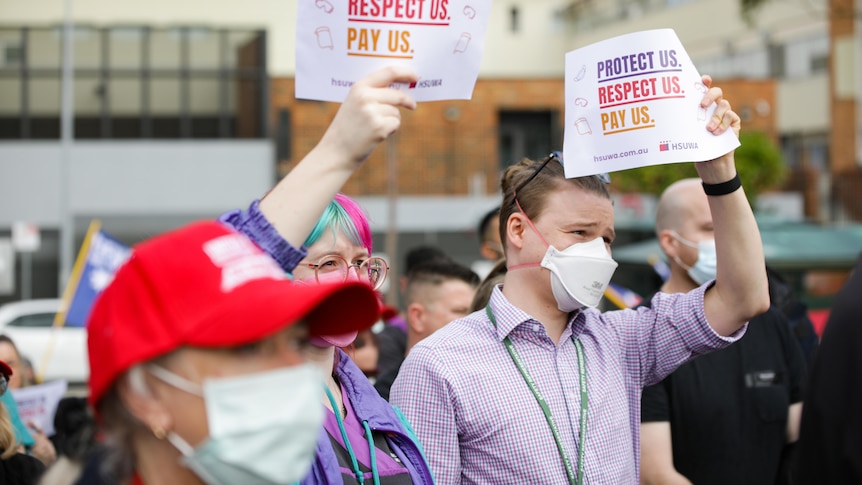The West Australian government will give all public sector workers a 3 per cent annual pay rise, over two years, and a one-off $2,500 payment, in an attempt to offset rising inflation and cost-of-living pressures.
Key points:
- More than 150,000 public sector workers will be offered a pay rise and one-off payment
- The changes will cost $634 million over the next four years
- UnionsWA says a one-off cash payment is no substitute for real base wage increase
Industrial action had been escalating in recent weeks over the West Australian government’s wages policy, with unions urging the state to lift its 2.75 per cent wage cap to reflect the soaring cost of living.
Public service employees who have already accepted the previous agreement — including teachers, doctors and transit guards — will receive the difference and have the one-off $2,500 payment paid to them in the coming weeks.
The new offer also includes a 0.5 per cent superannuation guarantee increase per year, over two years.
Premier Mark McGowan said the government wanted to recognize workers for their efforts during the pandemic.
“We’re going to change our wages policy and make it more generous for our public sector workforce, who are doing a terrific job, particularly over the COVID period,” Mr McGowan said.
“Our base pay rate is more generous than New South Wales’. It’s more generous than Victoria’s and I think it better reflects the expectations of the workforce.
“And, certainly for this year — for the vast majority of the workforce — it’s significantly above the inflation rate.
“We have significant competition for labour. It’s important we have a very vibrant, very successful economy, that we have a well-rewarded workforce, that we resolve these EBA issues, and we get back to the business of service delivery.”
The changes will apply to more than 150,000 public sector workers, with an expected price-tag of $634 million over the coming four years, bringing the total wages bill to $2.54 billion over that period.
Mr McGowan said that while the state government was doing all it could to alleviate cost-of-living pressures, it was also important to protect the state’s finances.
“Maintaining a good budget is very important to ensure that we have enough money to spend on what is important, and we don’t get ourselves into a difficult position and have the credit rating outcomes that other states and territories have had.”
The state’s Industrial Relations Minister Bill Johnston said the new wage policy offered the “right balance”.
“This is an important adjustment that reflects the changed circumstances that we’ve had since December last year,” he said.
“We’re responding appropriately. We have to protect the interests of the taxpayers, but we also have to be generous to the workforce.”
Many workers going ‘backwards’
UnionsWA has criticized the announcement, saying one-off cash payments are no substitute for real base wage increases.
However, it welcomed what it called the McGowan government’s recognition that its public sector wages policy did not meet the needs of workers in the state.
UnionsWA secretary Owen Whittle said low-wage public sector workers would benefit most, but others much less so.
“For many public sector workers — police, firefighters, child protection workers, prison officers — they’ve been going backwards for five years and this policy will ensure they continue to go backwards,” Mr Whittle said.
“One-off cash payments are not a substitute for real base wage increases for public sector workers.”
Mr Whittle said the announcement was made without consultation with unions.
“This isn’t genuine bargaining. We’re not in the room bargaining these pay increases. The government is just dropping this on us.”
The Australian Nurses Federation is still considering the wages offer, but indicated lowering workloads was as important as any pay rise.
That union’s Mark Olsen said the new offer was still not as good as that of nurses in most other states.
“It still leaves West Australian nurses and midwives as the second-lowest paid in the country, without any transparent regulation of their workloads,” Mr Olsen said.
Opposition questions long-term wages plan
Western Australia’s Shadow Treasurer, Steve Thomas, labeled the increase “moderately generous”, but said the government should do more to help those who are not in the public sector.
He renewed calls for government fees and charges to be frozen, at a cost of $160 million, which would benefit every West Australian.
Mr McGowan has previously said the current approach — which increases fees and charges at a rate below inflation and gives households a $400 electricity credit — delivers a better result than a freeze.
Dr Thomas also called for a discussion around the state’s wages policy over the longer-term, particularly as the iron ore price corrects, impacting the state’s bottom line.
“I would have liked to see an overall policy for cost of living. That is: a freeze on fees and charges, for at least the 2022-23 financial year,” he said.
“I would have then liked to see [the Premier] reassess the policy in the longer term and, instead of giving a one-off hit in terms of cash, [take] a genuine look at what the government can afford in terms of wage policy.”
.
